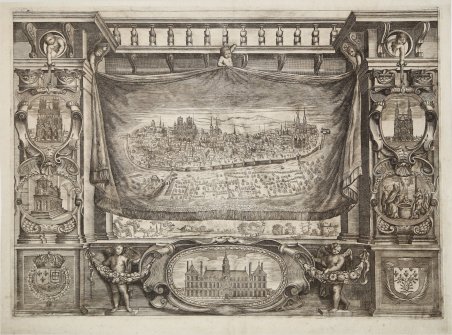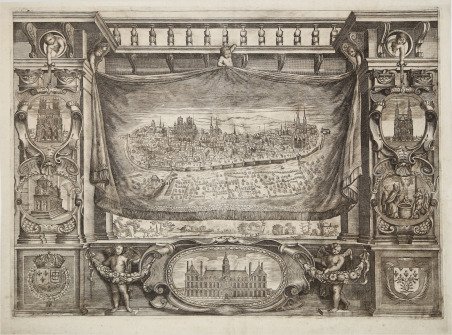Rarissima veduta prospettica della città di Reims, circa 1630, firmata in basso a sinistra E. Moreau fe & excudit. Acquaforte e bulino, impressa su carta vergata coeva, con margini, in ottimo stato id conservazione. Edmé Moreau era un incisore francese, nato nel febbraio 1596 a Châlons-en-Champagne e morto nel novembre 1648 a Reims.Nipote di Claude Chastillon, esercitò il suo mestiere a Reims dal 1617 fino alla sua morte, ma fu più attivo dal 1620 al 1648. Avrebbe anche lavorato a Parigi intorno al 1601. Le sue opere più importanti e migliori furono eseguite per la città di Reims, dove abitò in rue Saint-Étienne, poi lavorò con François Bernard al Griffon d'Or, Nicolas Hécart alla Bible d'Or e collaborò con l'incisore Nicolas Son. Durante la Prima Guerra Mondiale i suoi disegni e le matrici, che costituivano l'importante calcografia della città, furono danneggiate dall'incendio del 1917; poi restaurate e ricostituite dall'artista locale Abel Jamas. Le sue opere sono numerose; il suo bulino si distingueva per finezza e leggerezza. All'epoca l’arte dell'incisione era lontana dalla perfezione, ma Moreau sembra un precursore della grande scuola francese. Eseguì le sue opere più importanti e migliori per la città di Reims, tra cui tre piante prospettiche. La prima, derivante da un disegno dello zio Claude Chastillon, è datata 1622 ed è dedicata ai cittadini di Reims. Questa terza prospettiva, in ordine cronologico sebbene priva di data, è relativa a qualche anno dopo. Aggiunse una cornice di vignette – in un panneggio decorato con frange - che rappresentano le facciate degli edifici più prestigiosi della città, tra cui la cattedrale, il municipio, la tomba di Saint Remi, il portale di Saint-Nicaise, il battesimo di Clovis e le armi della città con il motto: "Dieu en soit garde". Questo tipo di veduta – sulla base delle mappe dei grandi editori olandesi Blaeu e Visscher -era divenuto molto di moda all’epoca. Opera di grande rarità. Bibliografia V Meyer, GBA 125 (1995), pp. 277-302 //// Very rare perspective view of the city of Reims, circa 1630, signed lower left E. Moreau fe & excudit. Etching and engraving, printed on contemporary laid paper, with margins, in excellent condition. Edmé Moreau was a French engraver, born in February 1596 in Châlons-en-Champagne and died in November 1648 in Reims. A nephew of Claude Chastillon, he practiced his craft in Reims from 1617 until his death, but was most active from 1620 to 1648. He would also have worked in Paris around 1601. His most important and best works were executed for the city of Reims, where he lived in the rue Saint-Étienne, then he worked with François Bernard at the Griffon d'Or, Nicolas Hécart at the Bible d'Or and collaborated with the engraver Nicolas Son. During World War I, his drawings and matrices, which constituted the city's important chalcography, were damaged by fire in 1917; then restored and reconstituted by local artist Abel Jamas. His works are numerous; his burin was distinguished by finesse and lightness. At the time, the art of engraving was far from perfect, but Moreau seems a precursor of the great French school. He executed his most important and best works for the city of Reims, including three perspective plans. The first, derived from a drawing by his uncle Claude Chastillon, is dated 1622 and is dedicated to the citizens of Reims. This third perspective, in chronological order although undated, relates to a few years later. He added a frame of vignettes - in a drapery decorated with bangs - representing the facades of the most prestigious buildings of the city, including the cathedral, the town hall, the tomb of Saint Remi, the portal of Saint-Nicaise, the baptism of Clovis and the arms of the city with the motto: "Dieu en soit garde". This type of view - based on the maps of the great Dutch publishers Blaeu and Visscher - had become very fashionable at the time. Work of great rarity. Bibliografia V Meyer, GBA 125 (1995), pp. 277-302


Scopri come utilizzare
Scopri come utilizzare
